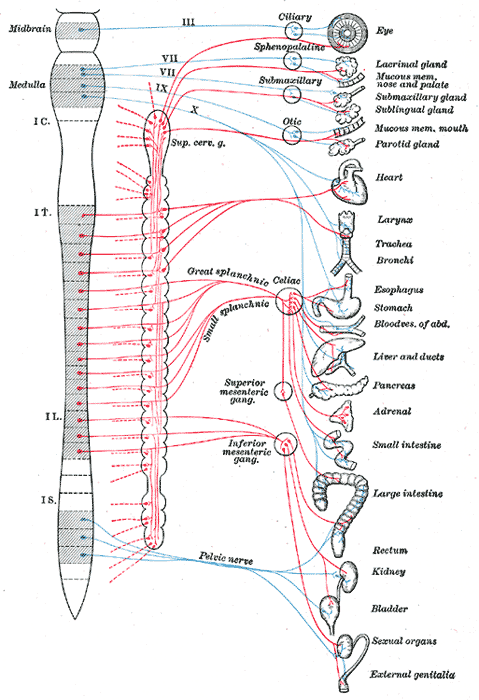Sympathetic nervous system
The sympathetic nervous system is part of the autonomic nervous system has the following functions:
- Diverts blood flow away from the gastro-intestinal (GI) tract and skin via vasoconstriction.
- Blood flow to skeletal muscles, the lung is not only maintained, but enhanced (by as much as 1200%, in the case of skeletal muscles).
- Dilates bronchioles of the lung, which allows for greater alveolar oxygen exchange.
- Increases heart rate and the contractility of cardiac cells (myocytes), thereby providing a mechanism for the enhanced blood flow to skeletal muscles.
- Dilates pupils and relaxes the lens, allowing more light to enter the eye.
Molecular biology
The pharmacogenetics of adrenergic beta-antagonist medications have been reviewed.[1]
Adrenergic receptor
Polymorphisms of the adrenergic receptor may affect clinical outcomes.[2]
Genetic polymorphisms of beta-1 (ADRB1) may affect the response to adrenergic beta-antagonist treatment of heart failure.[3]
Genetic polymorphisms of alpha-2C (ADRA2C) may affect the response to adrenergic beta-antagonist treatment of heart failure.[4]
G-protein-coupled receptor kinase
Polymorphisms of G-protein-coupled receptor kinase (GRK5) may underlie racial differences in the affect of treatment of heart failure.[5] There is conflicting evidence whether beta-blockers medications are as effective in African-American patients as in Anglo patients.[6] GRK5 may confer a natural "genetic beta-blockade".[7]
G protein–coupled cell surface receptor kinase 2 (GRK2) genetic polymorphisms may also affect the response to adrenergic beta-antagonists.[8]
Genetic polymorphisms of the protein kinase associated with β-2 adrenergic receptors may affect the response in asthma to adrenergic beta-agonists by patients of African descent.[9]
Cytochrome P-450
Polymorphisms of the cytochrome P-450, such as CYp2D6[10], are eligible for more drug interactions[11][12] and more inherited variation in metabolism[13].[14]
References
- ↑ Shin J, Johnson JA (June 2007). "Pharmacogenetics of beta-blockers". Pharmacotherapy 27 (6): 874–87. DOI:10.1592/phco.27.6.874. PMID 17542770. Research Blogging.
- ↑ Zaugg M, Bestmann L, Wacker J, et al (July 2007). "Adrenergic receptor genotype but not perioperative bisoprolol therapy may determine cardiovascular outcome in at-risk patients undergoing surgery with spinal block: the Swiss Beta Blocker in Spinal Anesthesia (BBSA) study: a double-blinded, placebo-controlled, multicenter trial with 1-year follow-up". Anesthesiology 107 (1): 33–44. DOI:10.1097/01.anes.0000267530.62344.a4. PMID 17585213. Research Blogging.
- ↑ Online Mendelian Inheritance in Man, OMIM®. Johns Hopkins University, Baltimore, MD. MIM Number: 109630. World Wide Web URL: http://omim.org/.
- ↑ Online Mendelian Inheritance in Man, OMIM®. Johns Hopkins University, Baltimore, MD. MIM Number: 104250. World Wide Web URL: http://omim.org/.
- ↑ Online Mendelian Inheritance in Man, OMIM®. Johns Hopkins University, Baltimore, MD. MIM Number: 600870. World Wide Web URL: http://omim.org/.
- ↑ Shekelle PG, Rich MW, Morton SC, et al (2003). "Efficacy of angiotensin-converting enzyme inhibitors and beta-blockers in the management of left ventricular systolic dysfunction according to race, gender, and diabetic status: a meta-analysis of major clinical trials". J. Am. Coll. Cardiol. 41 (9): 1529–38. PMID 12742294. [e]
- ↑ Liggett SB, Cresci S, Kelly RJ, et al. (May 2008). "A GRK5 polymorphism that inhibits beta-adrenergic receptor signaling is protective in heart failure". Nat. Med. 14 (5): 510–7. DOI:10.1038/nm1750. PMID 18425130. PMC 2596476. Research Blogging.
- ↑ Online Mendelian Inheritance in Man, OMIM®. Johns Hopkins University, Baltimore, MD. MIM Number: 109635. World Wide Web URL: http://omim.org/.
- ↑ Wang WC, Mihlbachler KA, Bleecker ER, Weiss ST, Liggett SB (August 2008). "A polymorphism of G-protein coupled receptor kinase5 alters agonist-promoted desensitization of beta2-adrenergic receptors". Pharmacogenet. Genomics 18 (8): 729–32. DOI:10.1097/FPC.0b013e32830967e9. PMID 18622265. Research Blogging.
- ↑ Online Mendelian Inheritance in Man, OMIM®. Johns Hopkins University, Baltimore, MD. MIM Number: 124030. World Wide Web URL: http://omim.org/.
- ↑ Phillips KA, Veenstra DL, Oren E, Lee JK, Sadee W (November 2001). "Potential role of pharmacogenomics in reducing drug-related side effects and adverse reactionss: a systematic review". JAMA 286 (18): 2270–9. PMID 11710893. [e]
- ↑ Weinshilboum R (February 2003). "Inheritance and drug response". N. Engl. J. Med. 348 (6): 529–37. DOI:10.1056/NEJMra020021. PMID 12571261. Research Blogging.
- ↑ Nozawa T, Taguchi M, Tahara K, et al (November 2005). "Influence of CYP2D6 genotype on metoprolol plasma concentration and beta-adrenergic inhibition during long-term treatment: a comparison with bisoprolol". J. Cardiovasc. Pharmacol. 46 (5): 713–20. PMID 16220080. [e]
- ↑ Online Mendelian Inheritance in Man, OMIM®. Johns Hopkins University, Baltimore, MD. MIM Number: 104250. World Wide Web URL: http://omim.org/.
